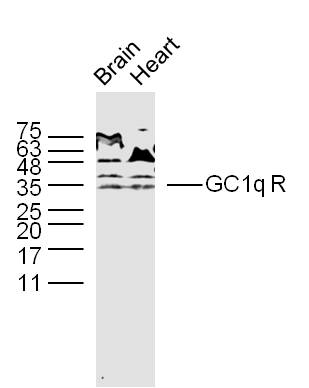
Rabbit Anti-GC1q R antibody
C1q globular domain binding protein; C1QBP; GC1q R; C1QBP_HUMAN antibody Complement component 1 q subcomponent binding protein; Complement component 1 Q subcomponent binding protein mitochondrial; Complement component 1 Q subcomponent-binding protein, mit
View History [Clear]
Details
Product Name GC1q R Chinese Name 透明质酸Binding protein1抗体 Alias C1q globular domain binding protein; C1QBP; GC1q R; C1QBP_HUMAN antibody Complement component 1 q subcomponent binding protein; Complement component 1 Q subcomponent binding protein mitochondrial; Complement component 1 Q subcomponent-binding protein, mitochondrial; GC1Q R; GC1q R protein; GC1q-R protein; GC1QBP; GC1QR; Glycoprotein gC1qBP; HABP 1; HABP1; Hyaluronan binding protein 1; Hyaluronan-binding protein 1; Mitochondrial matrix protein p32; p32 antibody p33 antibody Pre mrna splicing factor SF2 P32 subunit precursor; SF2p32; Splicing factor SF2 associated protein. Research Area Cell biology immunology The cell membrane受体 Immunogen Species Rabbit Clonality Polyclonal React Species Mouse, (predicted: Human, Rat, Dog, Pig, Sheep, ) Applications WB=1:500-2000 ELISA=1:5000-10000 IHC-P=1:100-500 IHC-F=1:100-500 ICC=1:100-500 IF=1:100-500 (Paraffin sections need antigen repair)
not yet tested in other applications.
optimal dilutions/concentrations should be determined by the end user.Theoretical molecular weight 24kDa Cellular localization The nucleus cytoplasmic Form Liquid Concentration 1mg/ml immunogen KLH conjugated synthetic peptide derived from human C1QBP: 101-200/282 Lsotype IgG Purification affinity purified by Protein A Buffer Solution 0.01M TBS(pH7.4) with 1% BSA, 0.03% Proclin300 and 50% Glycerol. Storage Shipped at 4℃. Store at -20 °C for one year. Avoid repeated freeze/thaw cycles. Attention This product as supplied is intended for research use only, not for use in human, therapeutic or diagnostic applications. PubMed PubMed Product Detail The human complement subcomponent C1q associates with C1r and C1s in order to yield the first component of the serum complement system (SCS). The SCS contains over 30 glycoproteins that influence physiological mechanisms of the body in response to immune complex (the classical pathway), carbohydrate (the lectin pathway) or bacterial (alternative pathway) initiation. C1q binding protein (C1QBP), also designated gC1q-R, p32 (p33) or HABP1 (hyaluronan-binding protein 1), is known to bind the globular heads of C1q molecules and inhibit C1 activation. C1QBP has been described as a complement receptor for C1q on B cells, neutrophils and mast cells. The C1QBP protein may form homodimers. C1QBP is expressed in vascular endothelial cells and has been found to be a multifunctional protein interacting with elements of complement, coagulation and kinin systems. In addition, C1QBP is a subunit of pre-mRNA splicing factor SF2/ASF.
Function:
Binds to the globular "heads" of C1Q thus inhibiting C1 activation.
Subunit:
Homotrimer; three monomers form a donut-shaped structure with an unusually asymmetric charge distribution on the surface. Interacts with CDK13, HRK, VTN, NFYB, ADRA1B, FOXC1, DDX21, DDX50, NCL, SRSF1, SRSF9 and CDKN2A isoform smARF. Interacts with CD93; the association may represent a cell surface C1q receptor. Interacts with KRT1; the association represents a cell surface kininogen receptor. Interacts with CD209; the interaction is indicative for a C1q:C1QBP:CD209 signaling complex. Interacts with FBL and RRP1; the respective interactions with C1QBP are competetive. Probably associates with the mitoribosome. Interacts with MAVS; the interaction occurs upon viral tansfection. Interacts with PPIF. Interacts with Rubella virus capsid protein; the interaction occurs in mitochondria. Interacts with Rubella virus protease p150, Staphylococcus aureus protein A/spa, HIV-1 Tat and HCV core protein.
Subcellular Location:
Mitochondrion matrix. Nucleus. Might also be nuclear in some cell types.
Tissue Specificity:
Expressed on cell surface of peripheral blood cells (at protein level); Surface expression is reported for macrophages and monocyte-derived dendritic cells.
Similarity:
Belongs to the MAM33 family.
SWISS:
Q07021
Gene ID:
708
Database links:Entrez Gene: 708 Human
Entrez Gene: 12261 Mouse
Omim: 601269 Human
SwissProt: Q07021 Human
SwissProt: O35658 Mouse
Unigene: 555866 Human
Unigene: 30049 Mouse
Unigene: 2765 Rat
Product Picture
Bought notes(bought amounts latest0)
No one bought this product
User Comment(Total0User Comment Num)
- No comment



 +86 571 56623320
+86 571 56623320
 +86 18668110335
+86 18668110335

